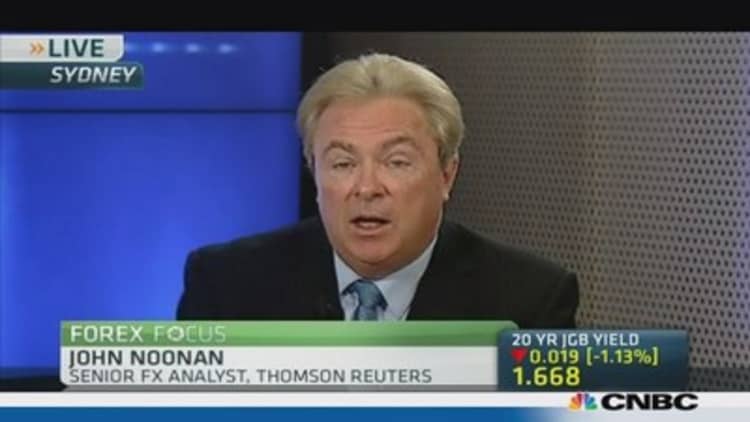The Australian dollar surged roughly 1.7 percent to its highest level since mid-June after the Federal Reserve shocked markets with its decision not to taper its asset purchase program. But analysts say the rally could be a mere knee-jerk reaction, noting the fundamental picture still points to weakness in the long term.
"Largely the rally can be attributed to a couple of events," said Michael Mattiussi, corporate foreign exchange dealer at Western Union Holdings, referring to recent positive data out of China coupled with the Fed's announcement on Wednesday.
"Unfortunately [the Aussie] might be held hostage again to headlines coming out of the Federal Reserve... when they do start to taper the Aussie will fall back to a range of US$0.80-US$0.90," he added.
(Read More: It seems the only way is down for the Aussie)
The Australian dollar has had a volatile run this year. After remaining stubbornly strong for the first four months of 2013, concerns over a slowdown in China, the end of the Australia's mining boom and dovish comments from the country's central bank helped knock the currency down to lows not seen in over three years, last month.
However, the Aussie has seen a turnaround over the past few weeks surging nearly 7 percent since the start of September, as signs of stabilization in China and the formation of a new government helped boost sentiment.
Some analysts believe the currency has bottomed out and have even gone as far as to describe it as a "screaming buy" but others were doubtful over how long the good times would last.
Keagan York, co-founder and director at Compass Global Markets, said he saw the Aussie moving slightly higher from current levels over the next few weeks, but said any substantial upside would be limited as tapering concerns come back to the fore.
"I think it might be the case that we get to US$0.96 or US$0.97 [but] we still can't see parity in the short term," he added. "The Aussie is stuck in a US$0.92 to US$0.97 range now probably until Christmas, because there is still an expectation that the tapering will happen next year."
(Read More: No Fed taper brings back talk of currency war)
York added that he expected Australian importers, together with deposit holders, to use this recent rally as an opportunity to get rid of some of their exposure to the Australian dollar, also capping any further gains.

Expectations for another rate cut from the Reserve Bank of Australia this year have been another bearish factor for the Aussie. Many analysts say a cut from the current level of 2.5 percent is already priced in.
Western Union's Mattiussi said he doubted Australia's central bankers would be happy with the recent rally.
"This will be frustrating for them so I guess it will play a role in any potential interest rate cuts over the next three to six months," he said.
However, if the RBA decided not to cut rates, and if some other drivers of the Aussie were to surprise on the positive side, the Aussie could see some near- to mid- term strength that could see it hit parity, added Mattiussi.
(Read More: Is the Aussie dollar heading for parity?)
"For it to get to parity we'd need all stars to align," he said. "We'd need Chinese growth to continue to be positive and stable. We'd need the RBA to hold back on cutting interest rates any further and we'd need the Fed to keep pushing back the beginning of tapering. [Only] then [does] parity start to become more realistic," he added.
Mattiussi added that, if the Aussie can remain above a key resistance level of US$0.94, that would put it on a decent platform for further gains.
The Aussie traded at US$0.9511 in late Asian trade on Thursday.
(Read More: Here are other ways to play the weak Aussie trade
— By CNBC's Katie Holliday: Follow her on Twitter @hollidaykatie


